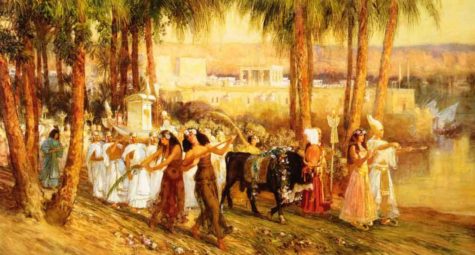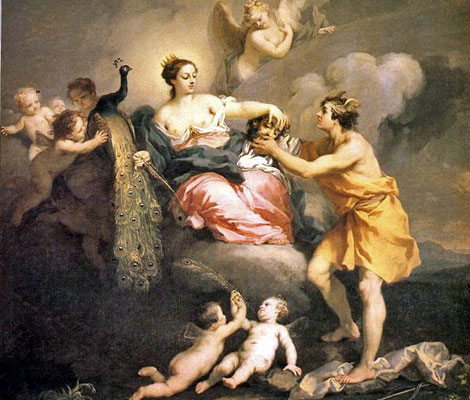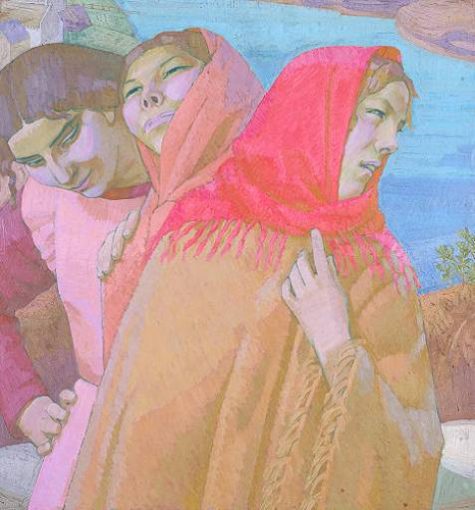shirleytwofeathers
When Egypt became part of the Roman Empire, Greek merchants brought the worship of Isis from Alexandria to Rome and invoked Her as inventor of the sail, patron of navigation, and ruler of the waves.
Possibly the most well known Isiac festival of the Roman world was the Navigium Isidis, celebrated on the 5th of March. As part of the festivities, a a festive carnival procession was performed in honor of Isis, and the Vessel of Isis, laden with offerings of precious spices and milk libations, is launched.
Here is a colorful and detailed eye-witness account of the procession and the ceremony:
Soon the sun of gold arose and sent the clouds of thick night flying; and lo, a crowd of people replenished the streets, filing in triumphal religious procession. It seemed to me that the whole world, independent of my own high spirits, was happy. The dusky clouds were routed; and the heavens shone with clear sheer splendor of their native light.
Presently the vanguard of the grand procession came in view. It was composed of a number of people in fancy dress of their own choosing; a man wearing a soldier’s sword-belt; another dressed as a huntsman, a thick cloak caught up to his waist with hunting knife and javelin; another who wore gilt sandals, a wig, a silk dress and expensive jewelry and pretended to be a woman.
Then a man with heavy boots, shield, helmet and sword, looking as though he had walked straight out of the gladiators’ school; a pretended magistrate with purple robe and rods of office; a philosopher with cloak, staff, clogs and billy-goat beard; a bird catcher, carrying lime and a long reed; a fisherman with another long reed and a fish hook.
Oh, yes, and a tame she-bear, dressed like a woman, carried in a sedan chair; and an ape in a straw hat and a saffron-coloured Phrygian cloak with a gold cup grasped in its paws – a caricature of Jupiter’s beautiful cup-bearer Ganymede.
Finally an ass with wings glued to its shoulders and a doddering old man seated on its rump; you would have laughed like anything at that pair, supposed to be Pegasus and Bellerophon. These fancy-dress comedians kept running in and out of the crowd, and behind them came the procession proper.
At the head walked women crowned with flowers, who pulled more flowers out of the folds of their beautiful white dresses and scattered them along the road; their joy in the Saviouress appeared in every gesture.
Next came women with polished mirrors tied to the backs of their heads, which gave all who followed them the illusion of coming to meet the Goddess, rather than marching before her.
Next, a party of women with ivory combs in their hands who made a pantomime of combing the Goddess’s royal hair, and another party with bottles of perfume who sprinkled the road with balsam and other precious perfumes; and behind these a mixed company of women and men who addressed the Goddess as “Daughter of the Stars” and propitiated her by carrying every sort of light – lamps, torches, wax-candles and so forth.
Next came musicians with pipes and flutes, followed by a party of carefully chosen choir-boys singing a hymn in which an inspired poet had explained the origin of the procession.
The temple pipers of the great god Serapis were there too, playing their religious anthem on pipes with slanting mouth-pieces and tubes curving around their right ears; also a number of beadles and whiffers crying: “Make way there, way for the Goddess!”
Then followed a great crowd of the Goddess’s initiates, men and women of all classes and every age, their pure white linen clothes shining brightly. The women wore their hair tied up in glossy coils under gauze head-dresses; the men’s heads were completely shaven, representing the Goddess’s bright earthly stars, and they carried rattles of brass, silver and even gold, which kept up a shrill and ceaseless tinkling.
The leading priests, also clothed in white linen drawn tight across their breasts and hanging down to their feet, carried the oracular emblems of the deity. The High Priest held a bright lamp, which was not at all like the lamps we use at night banquets; it was a golden boat-shaped affair with a tall tongue of flame mounting from a hole in the centre.
The second priest held an auxiliaria, or sacrificial pot, in each of his hands – the name refers to the Goddess’s providence in helping her devotees. The third priest carried a miniature palm-tree with gold leaves, also the serpent wand of Mercury. The fourth carried the model of a left hand with the fingers stretched out, which is an emblem of justice because the left hand, with its natural slowness and lack of any craft or subtlety, seems more impartial than the right. He also held a golden vessel, rounded in the shape of a woman’s breast, from the nipple of which a thin stream of milk fell to the ground. The fifth carried a winnowing fan woven with golden rods, not osiers. Then came a man, not one of the five, carrying a wine-jar.
Next in the procession followed those deities that deigned to walk on human feet. Here was the frightening messenger of the gods of Heaven, and of the gods of the dead: Anubis with a face black on one side, golden on the other, walking erect and holding his herald’s wand in one hand, and in the other a green palm branch. Behind, danced a man carrying on his shoulders, seated upright, the statue of a cow, representing the Goddess as the fruitful Mother of us all.
Then along came a priest with a box containing the secret implements of her wonderful cult. Another fortunate priest had an ancient emblem of her godhead hidden in the lap of his robe; this was not make in the shape of any beast, wild or tame, or any bird or human being, but the exquisite beauty of its workmanship no less than the originality of its design called for admiration and awe.
It was a symbol of the sublime and ineffable mysteries of the Goddess, which are never to be divulged a small vessel of burnished gold, upon which Egyptian hieroglyphics were thickly crowded with a rounded bottom, a long spout, and a generously curving handle along which sprawled an asp, raising his head and displaying its scaly, wrinkled, puffed-out throat…
Meanwhile the pageant moved slowly on and we approached the sea shore… There the divine emblems were arranged in due order and there with solemn prayers the chaste lipped priest consecrated and dedicated to the Goddess a beautifully built ship, with Egyptian hieroglyphics painted over the entire hull; but first he carefully purified it with a lighted torch, an egg and sulphur. The sail was shining white linen, inscribed in large letters with the prayer for the Goddess’s protection of shipping during the new sailing season.
The long fir mast with its shining head was now stepped, and we admired the gilded prow shaped like the neck of Isis’s sacred goose, and the long, highly-polished keel cut from a solid trunk of citrus-wood. Then all present, both priesthood and laity, began zealously stowing aboard winnowing-fans heaped with aromatics and other votive offerings and poured an abundant stream of milk into the sea as a libation.
When the ship was loaded with generous gifts and prayers for good fortune, they cut the anchor cables and she slipped across the bay with a serene breeze behind her that seemed to have sprung up for her sake alone. When she stood so far out to sea that we could no longer keep her in view, the priests took up the sacred emblems again and started happily back towards the temple, in the same orderly procession as before.
On our arrival the High Priest and the priests who carried the oracular emblems were admitted into the Goddess’s sanctuary with other initiates and restored them to their proper places. Then one of them, known as the Doctor of Divinity, presided at the gate of the sanctuary over a meeting of the Shrine-bearers, as the highest order of the priests of Isis are called. He went up into a high pulpit with a book and read out a Latin blessing upon “our liege lord, the Emperor, and upon the Senate, and upon the Order of Knights, and upon the Commons of Rome, and upon all sailors and all ships who owe obedience to the aforesaid powers.”
Then he uttered the traditional Greek formula, “Ploeaphesia”, meaning that vessels were now permitted to sail, to which the people responded with a great cheer and dispersed happily to their homes, taking all kinds of decorations with them; such as olive boughs, scent shrubs and garlands of flowers, but first kissing the feet of a silver statue of the Goddess that stood on the temple steps.
From: The Golden Ass
March 4th was the Greek festival of the Anthesteria, which was a celebration of flowers and dedicated to Flora. To celebrate this Spring festival of flowers, buy fresh flowers for your home. If you have house plants, repot and fertilize them. Burn a flowery incense, such as jasmine, rose or honeysuckle. Wear pastel colors to represent the delicate shades of the new Spring blossoms. Place a pretty bowl of fresh water on your altar and float a light flower in it.
When the moon is up, go to your altar and light a white candle. Sit in the darkness with only the candlelight. Look at the floating flower and think about the wonderful powers of Nature that bring the flowers back year after year. Contemplate the way this power touches your own life.
Feel your “roots” sinking deep down into the Earth, from which you can draw sustaining energy. Feel the energy being fed back to you. Now, reach your arms upward toward the Moon. Feel its energies adding to those of the Earth. Let these energies swirl around and through you, cleansing, healing, balancing. To break the flow, place both hands on the floor. Let the energies sink back into the Earth.
From: Moon Magick
This month was sacred to the Roman god Mars, hence the name March. Mars is similar to the Greek Ares, Tiu or Twaz of Central and Northern Europe, Teutates of the Celts, and Tyr of the Norse. The Roman goddess Bellona, goddess of war, had her special day during this month.
March is generally a blustery month weather-wise. The old weather saying “In like a lion, out like a lamb” is an apt description of March weather. For the Romans, it was the beginning of their year. The Spring Equinox, which falls around March 21 or 22, was a sacred and celebrated time in a great many world cultures. In the Southern Hemisphere, this would be equal to the Autumn Equinox, as the seasons are reversed. The Incas celebrated Pacha-puchy, or Earth Ripening, at this time.
The Roman Matronalia honored Juno Lucina, an aspect of the goddess Juno, who protected women, children and the family. Statues of the goddess were decorated with flowers, and special temple fires were lit. Girls made offerings to Juno Lucina at this time of year for happy and prosperous marriages.
The statue of Isis suckling her child symbolizes this goddess’s aspect as the Great Mother, the caretaker of the Earth and all life. Flowers were floated on the rivers and the boats blessed with incense.
In Canaan and other Semitic countries, the goddess Astarte was honored in a Spring celebration. Red eggs were given as gifts to family and friends, the beginning of our Easter egg tradition. Her sacred city of Byblos was noted for its extensive libraries before they were destroyed. As queen of heaven, Astarte wore crescent horns and was said to tirelessly create and destroy. The kings of Sidon ruled only with the goddess’s permission and called themselves the Priest of Astarte. Other cultures in the Middle East knew Astarte as Asherat of the Sea and Astart, queen of heaven.
Athene/Minerva,the armed goddess of wisdom,reigned over the biggest social event in Greece – the five day Spring competition featuring events in athletics, music, poetry and satire. Crowns of olive branches and flasks of olive oil were given to the winners of each event. On the final day, Athene’s birth was celebrated by draping the goddess’s statue in a new sacred garment.
This particular festival of Cybele, the Hilaria, was a happy time. Our word “hilarious” has similar word roots. The goddess Cybele can be compared to Demeter in many ways; Cybele represented the Earth as did Demeter and had a Spring resurrected son/lover Attis, who corresponded to Kore/Persephone. This happy festival celebrated the power of Cybele to overcome death.
Eostre was the German goddess of rebirth. Rabbits and colored eggs were fertility symbols connected with Her. Originally, Oestre was the goddess of the Spring Equinox whose name was changed to Easter by the Christians.
The Roman Luna, goddess of the Moon, was honored with the baking, exchanging, and eating of Moon cakes. Even the Chinese and Europeans knew of Moon cakes and some form of this goddess.
From: Moon Magick
Amaolikkervik Moon ~Inuit
Big Famine Moon ~Choctaw
Bud Moon ~Kiowa
Budding Trees Moon ~Medicine Wheel
Buffalo Calf Moon ~Arapaho, Sioux
Catching Fish Moon ~Agonquin
Chaste Moon ~Medieval English
Crow Moon ~Algonquin
Crane Moon ~Potawatomi
Crust Moon ~Algonquin
Deer Moon ~Natchez
Death Moon ~Neo-Pagan
Eagle Moon ~Cree
Fish Moon ~Colonial American
Green Moon ~Pima
Lenten Moon ~Cherokee
Little Frog Moon ~Omaha
Little Spring Moon ~Creek, Muscokee
Lizard Moon ~San Juan
Long Days Moon ~Wishram
Moon of Winds ~Celtic
Moose Hunter Moon ~Abenali
Much Lateness Moon ~Mohawk
Rain Moon ~Diegueno
Plow Moon ~Janic (full)
Sap Moon ~Algonquin
Seed Moon ~Janic (dark)
Snow Crust Moon ~Anishnaabe
Snow Sore Eyes Moon ~Dakota
Spring Moon ~Passamaquoddy
Strawberry ~Cherokee
Sugar Moon ~Algonquin
Whispering Wind Moon ~Hopi
Wind Strong Moon ~Taos
Windy Moon ~Cherokee
Worm Moon ~Algonquin
Holy Wells Day is a day dedicated to Caedda, the Celtic goddess of healing springs and wells.
Ceadda, an Old English Goddess of healing springs and wells, enjoys her holy day of celebration on March 2. While Her place in the hearts of the people has since been appropriated by St. Chad of Mercia, Catholic patron saint of wells, those of us who follow the old ways may care to pay homage to Ceadda today.
To lend energy to this maiden Goddess, visit a natural spring or well. Tidy up the grounds by picking up any refuse that you see on the ground, and leave a small gift of organic flowers or fruit near the water. Naturally sweet gifts are appropriate, as are organic cotton ribbons to bedeck the well.
Saying a few words for Ceadda is also appropriate. Speak from your heart, either out loud or silently, and tell Her how grateful you are for the living waters that spring from the Earth to heal and nourish us. If you wish, you may use this prayer:
Ceadda, Lady of healing waters,
Hear my grateful voice.
Please receive my gift of _______
In acknowledgement of your Divine work
Thank you for protecting and keeping the sacred springs and wells
I pay You homage and remember You
Sources: The Pagan Book of Days
A wonderful spiced and fruited cake which heralds the advent of Spring, simnel cake has a fascinating cultural heritage with roots that stretch back to the Romans and Athenians. In Britain, known as the Shrewsbury Simnel, it is simply made using white flour, fragrant spices and is generously studded with dried fruits and pungent peel.
Like a Christmas cake, it is covered with pale sweet almond paste. The decoration is plain – twelve little balls of smooth paste. A specially baked simnel cake is a wonderful gift to take to your mother for Matronalia, Mother’s Day, or Mothering Sunday Tea Time. Decorate it with crystalised flowers and tie some yellow ribbon around the side.
Ingredients:
For the almond paste:
- 400 g icing sugar, sifted
- 250 g ground almonds
- 1 large egg yolk, beaten lightly
- 3-4 tablespoons orange juice
- 5 drops almond essence
For the cake :
- 250 g plain flour
- 1 pinch salt
- 1 teaspoon nutmeg
- 1 teaspoon cinnamon
- 280 g currants
- 250 g sultanas
- 110 g mixed peel
- 160 g butter
- 160 g caster sugar
- 3 large eggs
- 200 ml milk, to mix
You will also need:
- a sifter,
- nest of bowls,
- food processor or electric beater,
- spatula,
- wooden spoon,
- 24 cm round cake tin,
- baking paper,
- brown paper and twine,
- rolling pin,
- thin metal skewer.
To make your own almond paste you will need:
- a food processor fitted with a steel blade.
- Don’t be tempted to use store-bought almond paste because it contains lots of sugar and few almonds, it will turn to liquid under the grill.
Directions:
Place icing sugar and almonds in food processor bowl. Process, slowly dripping in egg yolk, orange juice and almond essence. The mixture should form a pliable paste. Set aside a small portion for balls with which to decorate the cake. Roll out the remaining paste into 2 circles which are the approximate size of the tin. Set aside.
Preheat oven to 160°C/320°F.
Use a sturdy non-stick cake tub or line the buttered base with baking paper. As the baking period is long (1-1 1/2 hours), prevent the cake drying out by wrapping a double thickness of brown paper around the pan and securing it with twine.
Sift flour, salt and spices together, then stir in fruit and peel. Cream butter and sugar thoroughly until light and creamy then beat in eggs one at a time, until the mixture is fluffy. (Reserve a drop of egg yolk for brushing over top layer of almond paste.). Stir flour and fruit into creamed mixture (you may need to add a little milk to give the mixture a dropping consistency).
Place half the mixture into a greased and lined cake tin. Place one pre-rolled round of almond paste over the top. Cover with remaining cake mixture. Before baking the cake, give the pan of mixture a sharp tap on to a firm surface. This settles the mixture and prevents holes from forming in the cake.
Bake in the center of the oven for 1-1 1/4 hours or until a thin metal skewer inserted in the center of the cake comes out without a trace of stickiness. Level the cake by placing a weighted plate on top of the cooked cake while it is still hot.
Turn out cake on to a wire rack after leaving it to settle in the cake tin for between 10 and 15 minutes. Peel off paper and leave to cool completely.
Cover the top of the cake with a second round of almond paste. Roll 12 small balls of paste and place evenly around the top of the cake. Brush the top with a little beaten egg and very lightly brown under the grill until the almond paste turns light golden brown. Remove and leave to cool.
Note from someone who tried this recipe:
I did give the pan it’s tap to get rid of air bubbles but almost had a disaster when I went to take everything off so that I could set this on a cake rack to cool.. the almond paste in the middle was still liquid and was leaking down the sides of the cake at a great rate, so I quickly shoved it as neatly as I could back into the springform and let it cool completely before loosening it again. At least my baking paper helped stem the flow before I lost it all. Some of my twelve little balls slipped off while I had this in the oven the second time… so I’d advise not to put them too near to the edge of the cake.
In ancient Roman religion, the Matronalia (or Matronales Feriae) was a festival celebrating Juno Lucina, the goddess of childbirth (“Juno who brings children into the light”), and of motherhood (mater is “mother” in Latin) and women in general. In the original Roman calendar traditionally thought to have been established by Romulus, it was the first day of the year. As the first day of March (Martius), the month of Mars, it was also the Feriae Martis.
The date of the festival was associated with the dedication of a temple to Juno Lucina on the Esquiline Hill circa 268 BCE, and possibly also a commemoration of the peace between the Romans and the Sabines. On the day, women would participate in rituals at the temple, although the details have not been preserved other than the observation that they wore their hair loose (when Roman decorum otherwise required them to wear it up), and were not allowed to wear belts or to knot their clothing in any place.
At home, women received gifts from their husbands and daughters, and Roman husbands were expected to offer prayers for their wives. Women were also expected to prepare a meal for the household slaves (who were given the day off work), as Roman men did at the Saturnalia.
Patti Wigington at Paganwiccan.about.com wrote this nice little description about Matronalia.
This annual “festival of women” was held in honor of Juno Luciana, a goddess who watched over married women and those in childbirth. This aspect of Juno was associated with childbirth. The name lucina was thought to have come from the Latin word lux (light); thus, when a child was born it was said to have been “brought to light”.
In this aspect the goddess was a lunar deity, often paired with Diana and depicted as holding a torch. In the worship of Juno Lucina, women untied knots and unplaited their hair – sympathetic magic to prevent entanglements in the delivery of babies. She was in charge of newborn infants, and a woman in labor might make offerings to her so that she would have a safe delivery of a healthy child.
Women and girls prayed to her and brought offerings for prosperity in marriage. Gifts were exchanged, people feasted on similla, cakes decorated it with 12 balls of marzipan around the edges. and everyone treated the ladies exceptionally well on this day. Cakes with a similar name, simnel cakes, are associated with Mothering Sunday in England from which Mothers’ Day is derived.
Children of all ages were expected to pay a formal visit to their mothers and to bring a Simnel cake as a gift. In return, the mothers gave their children a special blessing. This custom was so well-established that masters were required to give servants enough time off to visit out-of-town mothers – provided the trip did not exceed 5 days!
Juno was the Roman Mother Goddess, known to the Greeks as Hera, and her original name to the Romans was Junonius. Juno is a counterpart of Janus and the divine watcher over the female sex, so this month is considered the best time to marry. As Juno Moneta, guardian of wealth and money, she had a temple on the Capitoline hill in Rome where the empire’s coins were minted.
Among Juno’s attributes, she is queen of heaven, approximating Frigg in the Northern Tradition, and Mary in the Christian. She is ruler of the high point of year, when there is maximum light and minimum darkness (the northern Summer Solstice).
Later on, Matronalia evolved into Mother’s Day in Europe, and was shifted to the fourth Sunday of Lent. During the Middle Ages, those who had moved away from home would return on this day to their “mother” church, visiting their families who still remained in the village. Servants were allowed to pick flowers from their masters’ gardens, and given the day off to return home; hence, the custom of bringing one’s mother some flowers on Mother’s Day.
In the United States, Mother’s Day actually falls in May, and is held in honor of humanitarian work carried out by women during the Civil War.
“You’re right to come, Marcher; your days demand their place
and the month that bears your stamp is here.”
~Ovid
March (Martius), the first month of the lunar calendar, was named after Mars and the entire month was dedicated to Him. The festivals reflected a purification and regeneration of the arms and fields, marking a time when farmers had to think of cultivating and protecting their lands. The efficacy of Mars’ divine aid was much needed in preparation for the seasonal crop growth and upcoming military campaigns, as wars often began or were renewed in the spring.
March 1st was the lunar calendar’s New Year’s Day, and may have also been Mars’ birthday. The festival of Quinquatrus (named for its length of five consecutive days) commenced on 19 March when the ancilia of the Salii and the weapons of the whole army were purified.
On 23 March, the Romans venerated Mars during the Tubilustrium, a cleansing ceremony for the trumpets used in sacred rites and the instruments of the entire army. A subsequent purification rite was performed on 19 October during the Armilustrium, and the Salii, commemorating the return of the legions in the fall, made their final procession through the streets of Rome. It signified the end of the military campaign season when arma (arms) and ancilia were purified and laid to rest for the winter.
How do we relate to Mars this month?
With Mars, there is no contemplation before action. The drive associated with Mars differs from that of the Sun in that it is self-assertion rather than assertion of the will; it is raw energy rather than creative energy.
Mars is still the essence of the god from antiquity. He is still the captivating aggressor, the rouser, and the protagonist of destiny; breathtakingly candid in His purpose and deliberate in His bounty. Mars personifies a vigorous energy that carries with it its own reproductive weight, immersed in singular ambition, and seldom outdone. He is the quintessential model of male sexuality; the catalyst for creation Who leaves little doubt that our perpetuation is imminent and our survival inevitable. Yet His artful passion is lucid; a flowing expression steeped in honorific intent and delivered with remarkably unbiased conveyance.
The expression of our basic needs remains the one true constant among all living beings. When we peel back the layers of aspirations and ideals, we reach the crux of the human race with uncanny fidelity; the instinctual drives that have served us so well. It is here, at this center that we find Mars, ceaselessly reminding us that no matter how far we venture from this place, the road back is always nearer than we realize.
How do we honor Mars this month?
Mars represents the instinctive nature still evident in all species: that of survival and protection. In antiquity, Mars’ reigning aspects were interwoven into a society that understood a definable application of pursuit and preservation. The Romans recognized the necessity of this sequence as the occurring truth behind any deliberate progress. These enduring principles are at the very heart of Perpituitas; qualities attributed to our role as the caretakers of our posterity.
In His warrior aspect we associate Mars with iron, but an iron will is of the same caliber. Protection has always been our gift to those we love, and a duty to ourselves. Though we no longer spend our days in the fields, the fruits of our labors still determine the quality of our life.
Pray to Mars when you need to shift into another gear, to bring your purpose from wishful pondering to fruition and culmination. Look to Mars when your spirit needs reawakening and you find yourself lost in the cycle of delay, needing to summon up the courage to act. When the mundane begins to chisel your determination into quiet resignation, let Mars hear your call to arms. His still powerful voice speaks volumes to all who listen. Mars continues to provoke and ignite while craftily providing us with His earthly wisdom; those universal gifts of our own nature which allow us to fully embrace our life’s experience and remain secure in our duration.
Source: Religioromana
- Colors: red, green, white
- Plants: Daffodils, leeks
- Activities: Send flowers, attend concerts, host a dinner party
Saint David’s Day is the feast day of Saint David, the patron saint of Wales, and falls on 1 March each year. The date of 1 March was chosen in remembrance of the death of Saint David on that day in 589, and has been celebrated by followers since then. The date was declared a national day of celebration within Wales in the 18th century.
The 17th century diarist Samuel Pepys noted how Welsh celebrations in London for St David’s day would spark wider counter-celebrations among their English neighbors: life-sized effigies of Welshmen were symbolically lynched, and by the 18th century the custom had arisen of confectioners producing ‘Taffies’ – gingerbread figures baked in the shape of a Welshman riding a goat – on St David’s Day.
In 2003 in the United States, St. David’s Day was recognized officially as the national day of the Welsh, and on 1 March the Empire State Building was floodlit in the national colors, red, green and white. It is invariably celebrated by Welsh societies throughout the world with dinners, parties, recitals and concerts.
To celebrate this day, people wear a symbol of either a leek, or daffodil. The leek arises from an occasion when a troop of Welsh were able to distinguish each other from a troop of English enemy dressed in similar fashion by wearing leeks. An alternative emblem developed in recent years is the daffodil.
Source: Unknown
I found this account of Mother March in an old book about Bulgaria, published in 1877. I love the way they used to celebrate the month of March. It occurs to me that it might be fun and informative to watch the weather this month and assign certain days to certain people and see what happens.
The month of March, which falls in the Spring equinox is called by the Bulgarians, Baba Mart, Old Mother March, and is the only female month of the year, the others being considered as masculine. March in Bulgaria is like April in England, inconstant and capricious, alternating between storms and sunshine; and it is here specially dedicated to the fair sex, who during its continuance enjoy complete idleness, doing no work, and asserting a sort of temporary superiority over their husbands, which sometimes even goes to the length of administering a thrashing, without fear of reprisal.
In order not to displease Baba Mart, the women do not even smear the floors of their houses with clay (a work which is usually performed every week), wash, weave, or spin; for if they were to do so Baba Mart would give no rain during the year, and lightning would infallibly strike the house in which she had been thus insulted.
There are certain clever old women who, knowing where Baba Mart resides, pay her a visit, and from her information assign to each of the married women a day of the month on which the weather will be according to the character of the lady whose day it is; thus, if Mrs. Dimitri gets the 1st of March, it will be fine, with perhaps a warm and gentle shower or two, for she is an amiable and soft-hearted woman, a little give to shedding unnecessary tears upon any pretext. Mrs. Tanaz is a loud-voiced shrew, so her day will be made up of wind, black clouds, snow, and heavy rain. “Don’t go out shooting tomorrow, Chelibi, for it is the day of Kodja Keraz’s wife, and she has such an awful temper that the weather is sure to be horrible.”
When a woman is assigned a day for the first time, her character is judged by the state of the weather; fortunately this system is not extended to young ladies on their promotion, or many a match might be broken off by an inopportune storm in the month of March.
Found in: Twelve Years study of the Eastern Question in Bulgaria













